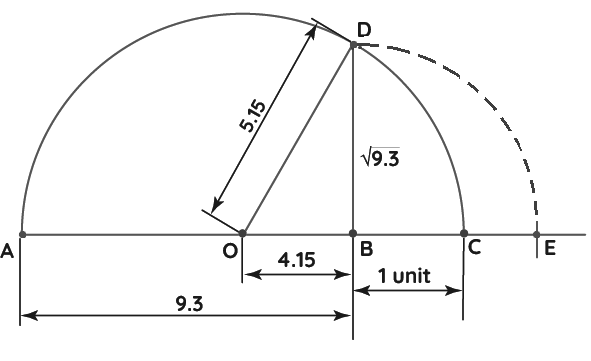NCERT Solutions Class 9 Maths
Chapter – 1 (Number Systems )
The NCERT Solutions in English Language for Class 9 Mathematics Chapter – 1 Number Systems Exercise 1.5 has been provided here to help the students in solving the questions from this exercise.
Chapter 1: Number Systems
- NCERT Solution Class 9 Maths Ex – 1.1
- NCERT Solution Class 9 Maths Ex – 1.2
- NCERT Solution Class 9 Maths Ex – 1.3
- NCERT Solution Class 9 Maths Ex – 1.4
- NCERT Solution Class 9 Maths Ex – 1.6
Exercise – 1.5
1. Classify the following numbers as rational or irrational:

Answer –
(i) 2 –√5
Since, it is a difference of a rational and an irrational number.
∴ 2 – √5 is an irrational number.
(ii) (3 +√23) – √23
⇒ (3 + √23) – √23 = 3 + √23 – √23
= 3
which is a rational number.
(iii)
⇒ =
, which is a rational number.
(iv)
∵ The quotient of rational and irrational number is an irrational number.
∴ is an irrational number.
(v) 2π
2π = 2 x π
∵ Product of a rational and an irrational number is an irrational number.
∴ 2π is an irrational number.
2. Simplify each of the following expressions:

Answer –
(i) (3 + √3)(2 + √2)
⇒ 2(3 + √3) + √2(3 + √3)
⇒ 6 + 2√3 + 3√2 + √6
(ii) (3 + √3)(3 – √3 )
⇒ (3)2 – (√3)2
⇒ 9 – 3
⇒ 6
(iii) (√5 + √2)2
⇒ (√5)2 + (√2)2 + 2(√5)(√2)
⇒ 5 + 2 + 2√10
⇒ 7 + 2√10
(iv) (√5 – √2)(√5 + √2)
⇒ (√5)2 – (√2)2
⇒ 5 – 2
⇒ 3
3. Recall, π is defined as the ratio of the circumference (say c) of a circle to its diameter, (say d). That is, π = . This seems to contradict the fact that π is irrational. How will you resolve this contradiction?
Answer – When we measure the length of a line with a scale or with any other device, we only get an approximate ational value, i.e. c and d both are irrational.
∴ is irrational and hence π is irrational.
Thus, there is no contradiction in saying that it is irrational.
4. Represent () on the number line.
Answer – Let’s look into the steps below to represent on the number line.
Step 1 – Draw a line and take AB = 9.3 units on it.
Step 2 – From B, measure a distance of 1 unit and mark C on the number line. Mark the midpoint of AC as O.
Step 3 – With ‘O’ as center and OC as radius, draw a semicircle.
Step 4 – At B, draw a perpendicular to cut the semicircle at D.
Step 5 – With B as a center and BD as radius draw an arc to cut the number line at E. Thus, taking B as the origin the distance BE =
Therefore, point E represents on the number line.

Let’s look at the proof shown below.
AB = 9.3, BC = 1
AC = AB + BC = 10.3
OC = =
= 5.15
OC = OD = 5.15
OB = OC – BC = 5.15 – 1 = 4.15
In right-angled ∆OBD, using Pythagoras theorem we have,
BD2 = OD2 – OB2
⟹ (5.15)2 – (4.15)2
⟹ (5.15 + 4.15)(5.15 – 4.15) [Using a² – b² = (a + b)(a – b)]
⟹ 9.3 × 1
⟹ 9.3
Hence, BD = = BE [Since they are the radii of the same circle]
Thus, we can say point E represents on the number line.
5. Rationalize the denominators of the following:

Answer –
(i)
Multiply and divide by
⇒ ×
⇒
(ii)
Dividing and multiplying by √7 + √6, we get
⇒
⇒ using the property, (a + b)(a – b) = a2 – b2
⇒
⇒
⇒ √7 + √6
(iii)
Dividing and multiplying by √5 – √2, we get
⇒
⇒ using the property, (a + b)(a – b) = a2 – b2
⇒
⇒
(iv)
Multiply and divide by (√7 + 2), we get
⇒
⇒ using the property, (a + b)(a – b) = a2 – b2
⇒
⇒

Leave a Reply